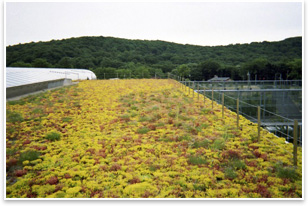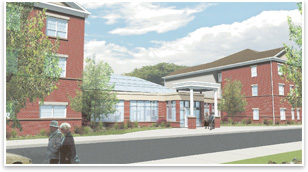
| Up on the Roof: Green Roof Will Boost Energy Savings for Philadelphia Senior Housing Development
How do you . . . cut energy consumption and storm water runoff with a living, breathing roof? Summary: The Philadelphia Housing Authority (PHA) recently broke ground on its first completely green building. Nellie Reynolds Gardens, an 85,000-square-foot housing development for low-income seniors, is being constructed on the site of a former victory garden in North Philadelphia. Crowned by a 20,000-square-foot green roof that will sport a bed of flowering plants, the $23.4-million development is slated to be a model of energy efficiency and a clean environment in this older, industrial neighborhood of Strawberry Mansion.
“The green roof has a positive effect on the whole ecosystem surrounding the building,” says Carl R. Greene, PHA executive director, who learned about green roofs at the 2006 AIA convention in Los Angeles. “We can hold this development out as a good example of reducing the cost of energy consumption. The building itself will be like what we are planning for the seniors, benefiting the lives, health, and strength of mind of its residents. It will blend with the environment, breathe natural air back into the atmosphere, and be part of an ecosystem of people and building systems that will endure for quite some time.” PHA’s first green roof facility, the Nellie Reynolds Apartments will sport a living carpet of low-growing foliage, to be installed by Philadelphia-based Roofscapes Inc. The four-inch-thick Roofrug® Green Roof will cover about half an acre and help the building save energy and absorb rain runoff. This vegetated roof cover will keep the building cool in the summer, moderate cold temperatures in the winter, reduce pollution by filtering rainwater, and prevent 300,000 gallons of runoff annually from flowing into the city sewer system. In the process, the green roof will protect and add to the roof’s life and value. Saving energy with a green roof
The Roofrug® profile is slim and light, with cuttings from several species of hardy sedums, or rock garden plants, in a three-inch mineral medium—a veneer, explains Miller. Once the temperate-climate plants take root and become established, the green roof will rely solely on natural rainfall. The eco-roof is intended to be low maintenance and drought resistant. Part of the stonecrop genus representing about 400 species of succulents, the green roof’s fleshy sedum foliage of varying colors provides uniform, flowering coverage over the entire area. The green layer also protects and extends the life of the roof. “The rainwater is retained in the soil and is actually protecting the roof,” mentions Miller. “There is no better buffer in terms of energy. Roofs experience large variations of temperature and exposure to sunlight and water.” Under the soil are a protective layer for waterproofing, and a drainage layer, so rainwater flows laterally to a drain. “When the fundamental materials are durable,” Miller says, “they protect the waterproofing below and the roof could last 20 years or more.” For PHA, the benefit is in lowering costs while being environmentally friendly. “It seemed to many of us who are energy conscious that this is a way to go,” says Greene. “We try to be out in front and look for contemporary ideas on being one with the environment.” A national leader in building energy-efficient, affordable housing, the PHA has completed 60 homes certified to the energy-efficient federal Energy Star standard. The nation’s fourth-largest public housing authority, PHA is Philadelphia’s largest landlord. Their commitment to constructing this totally green development also makes them eligible to receive Leadership in Energy and Environmental Design (LEED®) green building certification. Nellie Reynolds Gardens is expected to be completed in December 2008. Rooftop gardens Rooftop gardens have been planted on city rooftops since the 1930s, mentions Miller. “In New York City, there are a scattering of buildings with elaborate gardens on top, including Rockefeller Center,” says Miller. “The idea of gardens as being very thin, lightweight, and affordable is new; as well as thinking about them as both being part of building systems and a benefit to the city.“ Yet, with billions of square feet of roofing being produced annually in America, green roofing makes up only a fraction of that total, mentions Miller. “We are a tiny little slice of the American roofing industry.” Yet, he is optimistic. “Most people in cities have heard about green roofing, and architects are familiar with it, and we’re getting there.” |
||
Copyright 2007 The American Institute of Architects. All rights reserved. Home Page |
||
news headlines
practice
business
design
recent related
› Sedums Grow in Downtown Washington
Photo One: The Roofrug ® Green Roof at Nellie Reynolds Gardens will provide substantial cooling in the summer and moderate the cold temperatures in winter.
Photo © Roofscapes, Inc.
Did you know . . .
The American Society of Landscape Architects headquarters has a green roof now? For details, visit the ASLA Web site.



